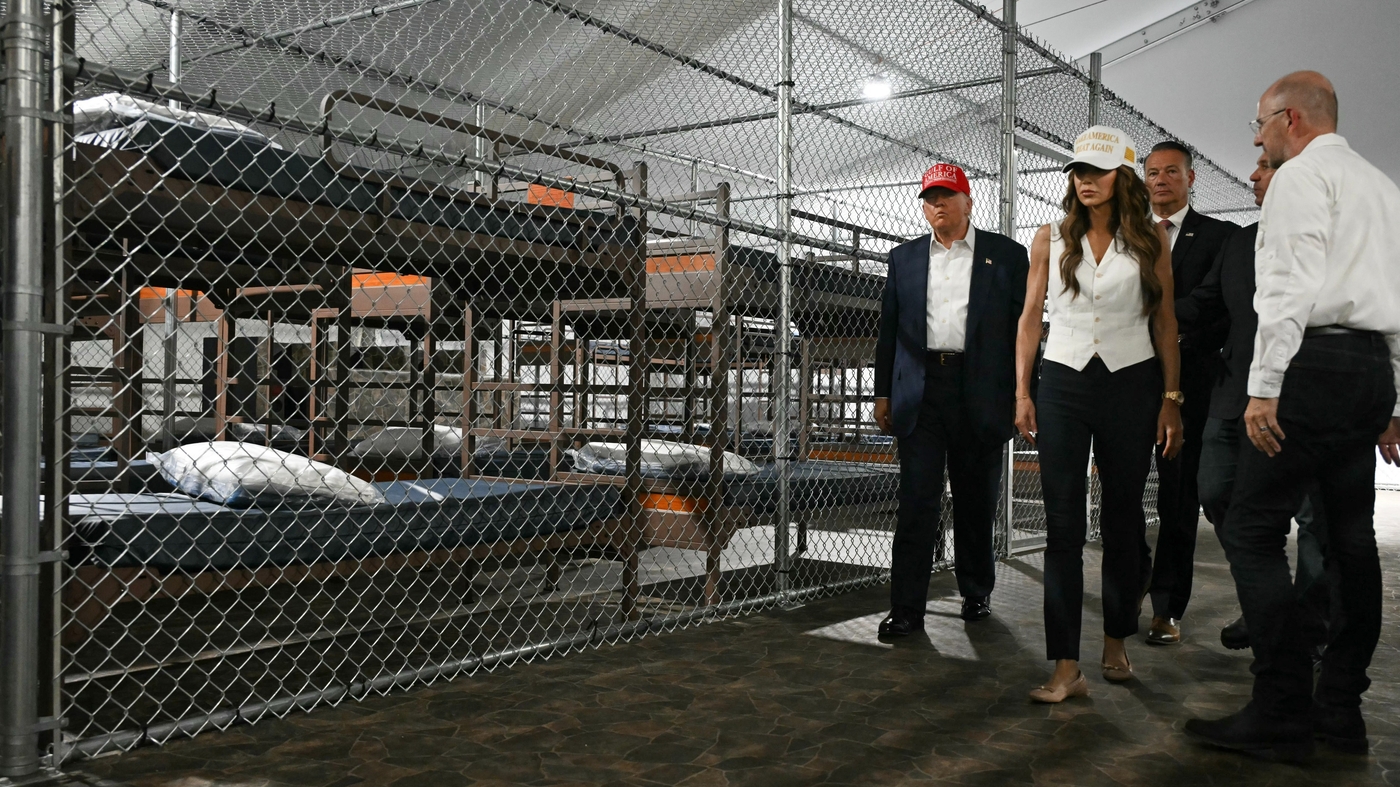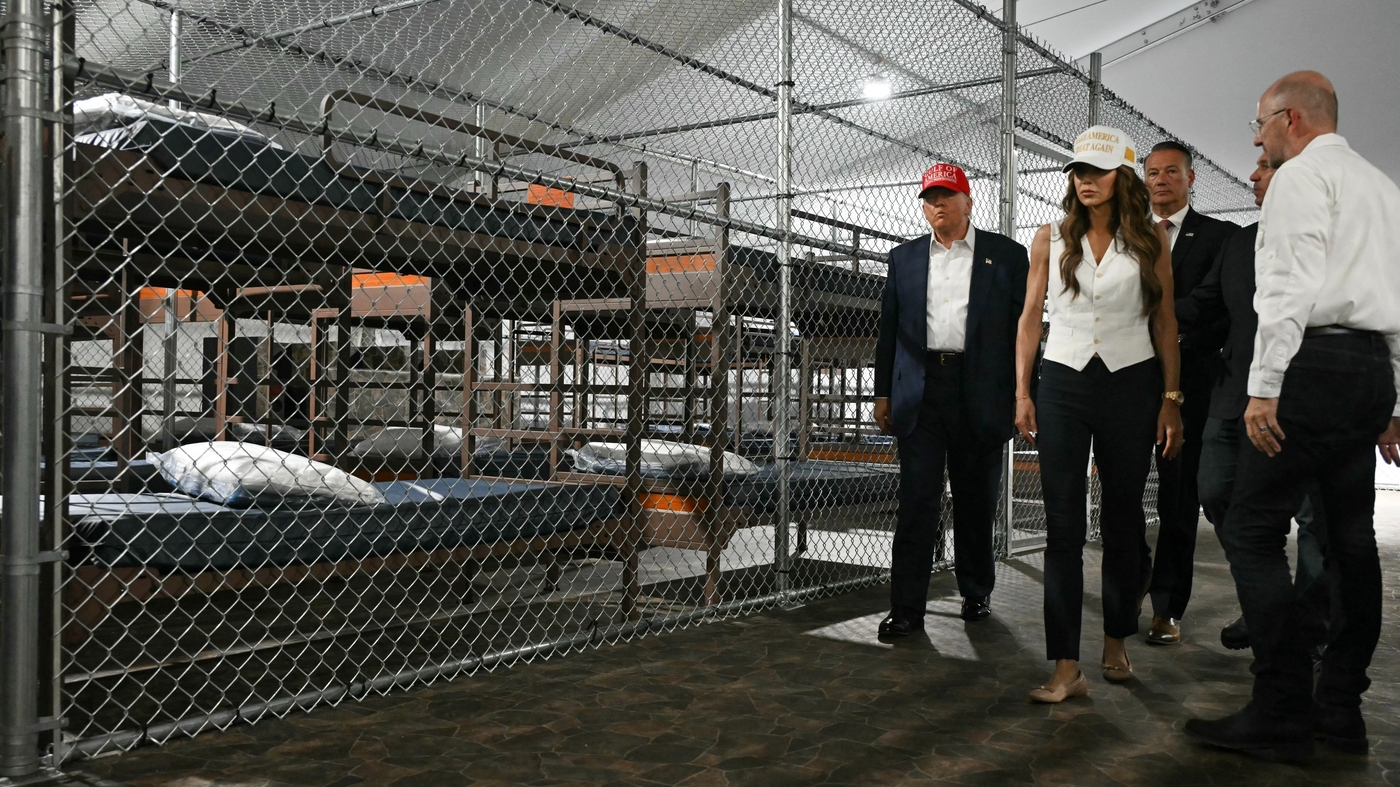The “Shock and Awe” Strategy: A Comprehensive Analysis of Trump’s Second-Term Immigration Enforcement
Introduction: A New Era of Immigration Enforcement
The return of President Donald Trump to the White House has ushered in a new era of immigration enforcement, marked by a rapid and aggressive approach designed to send a clear message to both potential migrants and the American public. This strategy, dubbed “shock and awe,” has been implemented with remarkable speed and intensity, reshaping the landscape of federal immigration policy within the first six months of the second term. The goal is to create a sense of disruption and deterrence, amplifying the administration’s promises of stricter border control and mass deportations.
The “Shock and Awe” Doctrine: A Military Strategy Applied to Immigration
The term “shock and awe” originates from military strategy, where it describes the use of overwhelming force to paralyze the enemy’s ability to respond. In the context of immigration enforcement, the Trump administration has adopted this doctrine to implement a series of rapid and impactful measures. The strategy aims to create a sense of disruption and deter illegal immigration by amplifying the administration’s promises of stricter border control and mass deportations.
Key Components of the Strategy
Policy Changes and Their Impacts: A Closer Look
The administration’s “shock and awe” strategy has been implemented through several policy changes, each with far-reaching consequences for immigrants and the broader society.
Expanded Enforcement Priorities
One of the first actions taken by the Trump administration was to broaden the scope of enforcement priorities. While previous administrations focused on deporting individuals with serious criminal records, the Trump administration has expanded its targets to include anyone in the country illegally. This has led to the arrest and deportation of individuals with minor offenses or no criminal record at all, creating fear and uncertainty within immigrant communities.
The impact of this policy shift has been profound. Immigrant communities, particularly those with mixed-status families, have reported increased levels of anxiety and fear. Many immigrants are afraid to report crimes or seek medical care for fear of being deported. This has created a chilling effect on community policing and public health efforts, as immigrants become reluctant to interact with law enforcement or access essential services.
Restrictions on Asylum
The administration has also implemented policies designed to restrict access to asylum. These include measures that make it more difficult for asylum seekers to enter the country, such as the Migrant Protection Protocols (MPP), which require asylum seekers to remain in Mexico while their cases are processed. These policies have been criticized by human rights organizations for exposing vulnerable individuals to dangerous conditions and limiting their access to legal protections.
The MPP, for instance, has been widely condemned for its impact on vulnerable populations, particularly women and children. Asylum seekers forced to remain in Mexico often face extreme violence, exploitation, and inadequate access to legal representation. This has led to a surge in human rights abuses and a backlog of asylum cases, further straining the already overwhelmed immigration system.
Increased Border Security
Another key component of the “shock and awe” strategy is increased border security. The administration has continued to push for the construction of a wall along the U.S.-Mexico border, and has deployed additional personnel and technology to deter illegal crossings. These measures have been accompanied by increased enforcement actions against individuals who attempt to enter the country illegally, leading to a surge in arrests and detentions.
The impact of these measures on border communities has been significant. While proponents argue that increased border security is necessary to deter illegal immigration, critics point to the human cost of these policies. The construction of the border wall, for instance, has disrupted ecosystems, displaced wildlife, and divided communities. Additionally, the increased presence of border patrol agents has led to reports of abuse and misconduct, further straining relations between law enforcement and immigrant communities.
Funding and Resources: The Financial Backbone of the Strategy
The “shock and awe” strategy has been accompanied by a significant increase in funding for immigration enforcement agencies. Congress has approved tens of billions of dollars in additional funding, making it the largest domestic enforcement funding in U.S. history. This funding has been used to hire additional ICE agents, expand detention facilities, and acquire new technologies for border surveillance.
Impacts of Increased Funding
Legal Challenges and Resistance: The Pushback Against the Strategy
The Trump administration’s immigration policies have faced numerous legal challenges, with dozens of judges across the country ruling against them. These challenges have focused on issues such as due process, asylum rights, and the separation of powers.
Court Rulings
Several courts have blocked the administration’s attempts to restrict asylum access, ruling that they violate U.S. and international law. For instance, the MPP has been challenged in multiple courts, with judges ruling that the policy violates the rights of asylum seekers and exposes them to dangerous conditions. Other courts have challenged the administration’s efforts to expand deportation grounds, arguing that they exceed the authority granted by Congress.
Resistance from States and Localities
In addition to legal challenges, the administration’s policies have faced resistance from states and localities. Some states have passed laws to protect immigrant communities and limit cooperation with federal immigration enforcement efforts. For example, California has implemented policies that restrict local law enforcement’s cooperation with ICE, creating “sanctuary” jurisdictions that limit the ability of federal agents to conduct raids and arrests.
This resistance has created a patchwork of immigration enforcement policies across the country, with some states and localities actively resisting federal efforts. This has led to tensions between state and federal governments, as well as debates about the role of local law enforcement in immigration enforcement.
The Human Cost: The Real Impact of the Strategy
While the “shock and awe” strategy may achieve some of its intended goals, it comes at a significant human cost. The increased enforcement actions and restrictive policies have created fear and anxiety within immigrant communities, separating families and disrupting lives.
Separation of Families
One of the most controversial aspects of the administration’s policies has been the separation of families at the border. Under the “zero tolerance” policy, parents who crossed the border illegally were prosecuted, leading to the separation of children from their parents. This policy has been widely condemned by human rights organizations and child welfare advocates, with reports of children being held in inhumane conditions and subjected to psychological trauma.
The impact of family separation on children and parents has been profound. Many children have been separated from their parents for extended periods, with some never being reunited. This has led to long-term psychological and emotional harm, as well as legal challenges to the policy.
Impact on Communities
The increased enforcement actions have also had a chilling effect on immigrant communities, making it more difficult for immigrants to access essential services such as healthcare and education. Many immigrants are afraid to report crimes or seek medical care for fear of being deported. This has created a climate of fear and distrust, as well as a strain on community resources.
Additionally, the increased enforcement actions have led to a surge in deportations, disrupting families and communities. Many immigrants who have lived in the U.S. for years, if not decades, have been deported, leaving behind spouses, children, and other family members. This has created a humanitarian crisis, as well as economic and social challenges for the communities affected.
The Future of Immigration Enforcement: Uncertainty and Challenges
The future of immigration enforcement under the Trump administration remains uncertain. While the administration has achieved some successes in implementing its “shock and awe” strategy, it faces significant legal and political challenges.
Potential Scenarios
Conclusion: A Legacy of Disruption and Uncertainty
Six months into President Trump’s second term, the “shock and awe” immigration enforcement strategy has undeniably left a mark. While proponents tout its effectiveness in deterring illegal immigration, critics highlight the human cost and legal challenges. This period has been characterized by disruption, uncertainty, and a reshaping of the landscape of immigration policy, the long-term effects of which remain to be seen.
The strategy has succeeded in creating a sense of disruption and deterrence, amplifying the administration’s promises of stricter border control and mass deportations. However, it has also created a climate of fear and anxiety within immigrant communities, as well as legal and political challenges that will continue to shape the debate over immigration policy in the years to come. As the administration moves forward, it will need to balance its enforcement priorities with the need to address the human cost of its policies and the legal challenges they face. The legacy of this strategy will ultimately be determined by its long-term impact on immigration policy, the lives of immigrants, and the broader society.








